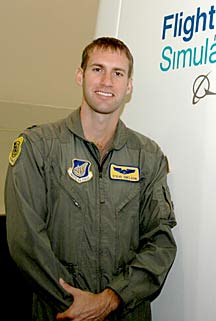C-17 simulator
amazes pilots
The state-of-the-art training
module can mimic every possible
runway and air fluke
The precision and the resolution are so detailed that pilots can feel "every crack" on the concrete runway even though they are in a simulator miles away from the cockpit of a C-17 Globemaster jet.
![]()

![]()
Capt. Steve Snelson: Pilot is helping Hickam units prepare for the Air Force's new cargo jet
The cockpit simulator, more than two stories high, is part of the three-building $190 million complex undergoing final preparations in anticipation of the first Air Force cargo jet, which will arrive in the islands in February. The remaining seven jets will be sent to Hickam at a rate of one each month. Hickam's first C-17 -- dubbed "Hawaii One" -- was blessed Aug. 19 by retired Master Sgt. Raymond Ganotise at Boeing's Long Beach plant.
Eventually Hickam Air Force Base will have eight C-17 cargo jets, which will be flown and maintained by the first partnership of active duty Air Force and Air National Guard personnel. The active duty portion of the more than 150-member unit will be the 535th Airlift Squadron, commanded by Lt. Col. Chris Davis. The other component will be the Hawaii Air National Guard's 204th Airlift Squadron, which will be led by Lt. Col. Scott Kinsey.
Eventually there will be 40 air crews, with three coming from the active Air Force and five from the Hawaii Air National Guard. Each of the eight cargo jets will be assigned five crews. Its maintenance section will have a similar mixture of active Air Force and Hawaii Air National Guard personnel.
Capt. Steve Snelson, who has spent all of his eight years in the cockpit of a C-17, is one of six Air Force pilots here working on the transition. The unit eventually will have 10 active duty Air Force pilots and eight from the Hawaii Air Guard.
Snelson, 30, has seen the evolution in C-17 cockpit simulators since he left Air Force flight school in 1998.
Sisco, an Air Force avionics specialist for 24 years before he joined Boeing, said Hickam's C-17 simulator is "not only state-of-the-art," but also the only one that uses an electronic motion system rather than hydraulics to mimic the six basic motions an aircraft and its crew could experience -- pitch, roll, yaw, slip, heave (up and down motions) and sway.
"It's a pretty impressive device," Snelson added.
The simulator cockpit lays out the instrument panel and other controls for the pilot, who sits in the left side of the aircraft, and his co-pilot. An instructor sits behind the co-pilot.
Computers are used to reproduce varying weather and environmental conditions a C-17 crew could face, shown on the Mylar concave mirrors that surround the cockpit simulator.
A three-hour training session is run by an evaluator, like Snelson, who sits at the back of the cockpit and controls the bank of computers that can create a myriad of weather conditions and at least 500 aircraft malfunctions.
Snelson said the evaluator "can create artificial weather conditions, even cloud cover, and situations you rarely have to fly in."
The intent is to try to create every emergency and engine malfunction that a C-17 crew could encounter on any given mission.
Every C-17 pilot is required to spend time in a simulator every quarter to get a refresher on emergency procedures and even routine operations like refueling.
Snelson said the simulator can be programmed to "even simulate a surface-to-air missile strike. It forces a crew to think logically, to go through the checklist and make it better prepared for the real thing."
It also gives an air crew the opportunity to digitally and visually prepare for any mission.
Snelson recalls a May 2004 night air drop mission in Afghanistan. His crew, equipped with night vision goggles, was able to first "fly" the entire mission from Germany to Afghanistan and back in a simulator.
"We were able to actually see the terrain through a valley," Snelson said.
He said the success of the 16-hour mission can be attributed to the confidence the air crews received in flying it in the simulator beforehand.
E-mail to City Desk
[News] [Business] [Features] [Sports] [Editorial] [Do It Electric!]
[Classified Ads] [Search] [Subscribe] [Info] [Letter to Editor]
[Feedback]
